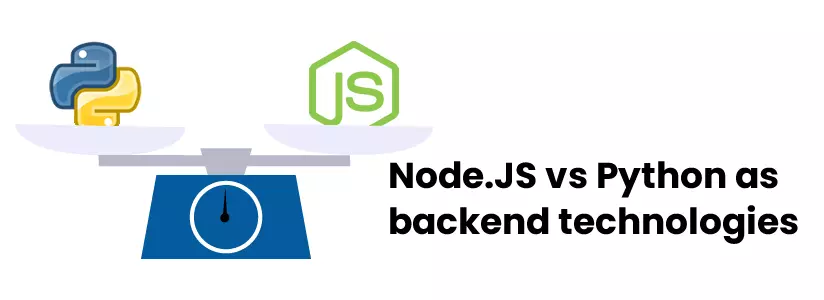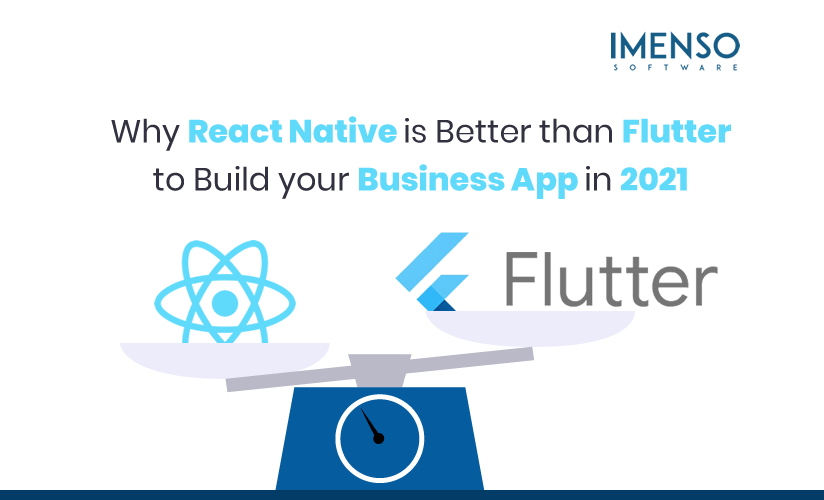Node.JS Vs Python: Pick the Best Backend Technology in 2022

The battle between Node.js and python for the best backend technology is always on. One is old and established while the other one is new and trending. Which will win the war? Let’s dive in.
Picking the right technology stack is pivotal for a web application project. The frontend and backend technology combination decides the project cost, efficiency, and launch timeline.
For those of you not aware of frontend and backend technology, here’s a quick brush up:
Frontend – it is the part of the application or website which is visible on the screen, the color, themes, layout, etc. frontend is also known as client-side rendering.
Backend – it is the part of the application which gives the technical working. For example, when you click on the buy now button on a product page, it takes you to the next page for checkout. These links are fetched from a database and presented on the screen from a server which is done via backend engineering or server-side rendering.
Backend is an important coding part of any application and website. It adds usability and performance to your app.
Both Node.js and python are popular backend technology choices and both have the functionality to add that extra flair to your application.
Choosing one for your next project is challenging and if you are confused, keep reading our blog.
Node.JS vs Python as backend technologies

Before we move further down the comparison lane, let’s understand both technologies.
Also Read: Python vs PHP – Which One is Better?
What is Node.JS?
Node.js is among the top-rated backend frameworks for 2022. It uses an event-driven model, which helps developers process multiple requests without affecting other input/output operations. It is built on the JavaScript engine and used to create real-time applications which can run on multiple OSs including Windows, OS X, and others.
What is Python?
Python is used for multipurpose and object-oriented programming. It is a dynamic programming language that has been around for 30 years! The old backend framework has been updated regularly and is among the best tech stack to build sturdy business applications. Python has many APIs and libraries which helps developers code excellent web apps faster.
1. Node.JS vs Python – Scalability
Large corporations, startups, and SMBs need tech resources for business growth. For creating an MVP, any language/coding strategy will suffice but the scalability of web applications needs much more. Features, functionalities, consumer demands, traffic everything grows in equal proportions as the application scales.
Node.js
Node.js adds a lot of flexibility to application development. There is no need to create a core and then scale applications around it. Instead, developers built modules and service sets such that while scaling they run their own processes. Both horizontal and vertical expansion is possible with Node.js by adding nodes and resources.
Python
Python doesn’t have multi-thread support. As the number of requests increases, python does not allow several threads to operate at once. Python is built on global interpreter lock which means processes have to run sequentially.
Also Read: Are You Looking To Hire React Native Developers To Build Mobile Apps?
Scaling with a python environment has many drawbacks. A large development team can’t run multiple threads simultaneously which reduces the speed of the application significantly.
Result:
Node.js offers better flexibility and low code maintenance while scaling, thus it is a better choice than python.
2. Node.JS vs Python – Architecture
Node.js is based on a single-threaded event loop architecture. This single event receives all execution requests. On the other hand, python uses interchangeable code modules for a long list of requests.
Node.js
Node.js has a runtime environment with asynchronous programming which means I/O functionality is not affected due to any change in the code.
One can run multiple processes for faster development. Node.js can take new instructions while the old ones are running.
From a business perspective, multi request functionality is excellent as it reduces the time required for the development.
Python
As we discussed earlier, python does not support multi-thread functionalities. One process must end before other ones can start execution. This old processing makes python a little restrictive. While there are frameworks and tools available to enhance python programming and create asynchronous apps, they are not as effective as an inherent asynchronous environment.
Result:
Thanks to its more modern and favorable architecture, Node.js wins this round as well.
3. Node.JS vs Python – Performance & Speed
Every strand of speed adds an extra edge to an application in terms of performance and operation cost. Both performance and speed are crucial to creating a functional app for consumers and improving business profits.
Node.js
Node.js has a much simpler and faster execution process. Its non-blocking request handling is the perk that makes Node.js a strong competitor. It also offers a cherry on the cake – Node.js executes code out of the browser.
This way the apps which run on web browsers also acquire speed and deliver high efficiency.
Python
Python’s object-oriented programming and no support for multi-thread is a roadblock in this battle as well. Resolving one request at one time slows down the processes and thus the speed of the application.
Non-parallel execution is not fast enough for 2022. Apps take too long to fetch data from the server which causes lagging in performance and delivery.
Result:
Due to its innate architecture, python is not ideal for speed and performance. Node.js wins here too.
4. Node.JS vs Python – Tools & Libraries
Libraries are hacks for app development tech stack. The rise of tools, frameworks, and libraries has pushed software development so much in the last decade.
Libraries are predesigned codes for features that have already been devised. No need to start writing code from scratch. Instead, integrate code directly from the library for the features you want.
Also Read: Why Is Software Development A Need For Businesses In 2022
The number of such libraries is not important, it’s the documentation available that makes it useful.
Node.js
Node.js has the largest repository of packages on the internet. It’s very well documented with 350,000 packages which are managed by node package manager.
Python
Python libraries are well documented and very comprehensive. They are easy to deploy and are available in handy packages. However, the new additions are not as reliable as the old ones.
Result:
For libraries and tools, both python and Node.js are on the same pointer. You get a variety of choices in terms of technology and package. It’s a tie.
5. Node.JS vs Python – Extensibility
The world is moving towards no code and it is no surprise at all. As customer demand changes, so does the business needs to deliver. Extensibility is essential for such rapid adaptation and delivery.
Extensibility is the ability to add features via third-party tools. More extensibility means new features can be added and applications are modified without any fuss.
Node.js
Node.js has many options for extensibility, like babel for front-end development, jasmine for unit testing, and many more. Webpack, PM2, and express are among the most compatible frameworks used with Node.js.
Python
Python also has a bucket load of frameworks to extend features and capabilities, like robot framework, sublime text, Django, web2Py, and others.
Result:
Both Node.js and python have relatively equal extensibility. Here also both wins.
Also Read: PHP vs Node.js – Which is the Better Programming Language?
Conclusion
Choosing between the best options is always hard. Node.js and python can be equally good for app development projects. Both have full flagged features and benefits which can mess up your mind.
The simple solution – focus on your product’s end goal. Listing all the features from the end-user perspective is the quickest way to plan your project development. Based on this analysis, picking the right runtime environment becomes easy.
If you are still facing trouble picking one, feel free to send your queries to info@imensosoftware.com. Our experts will be glad to offer you more suggestions for your next project.
Similar Posts

How to Build a Scalable eCommerce Platform with MEAN Stack
In the modern digital era, the eCommerce industry has grown exponentially, and online shopping has become an integral part of our daily lives. With the increasing demand for online shopping, businesses need to build scalable eCommerce platforms that can handle large volumes of traffic, transactions, and users. This is where the MEAN stack Development services […]...

How Can Predictive Analytics Empower Your Decision-Making With Power BI?
Are you tired of making business decisions based on gut feelings or outdated information? Are you struggling to stay ahead of the competition in an increasingly data-driven world? If so, you’re not alone. Many business professionals face the challenge of harnessing the power of data to make accurate forecasts and drive their organizations forward. That’s […]...

Why React Native is Better than Flutter to Build your Business App in 2021
The use of mobile devices has increased exponentially in the last decade. Today, we use it to make travel plans, order food, book cabs, and much, much more. Having an official company website isn’t enough in 2021. That is the major reason why every business, global or local has an app too to connect with customers on […]...








